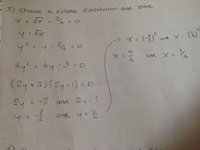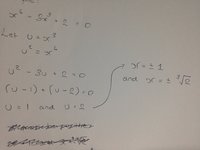LostInLunacy
New member
- Joined
- Apr 29, 2020
- Messages
- 4
Hi. I have been doing these 'quadratic equations in disguise' questions, but I am finding them quite challenging.
Exact wording:
Choose a suitable substitution and solve the equation:
1) [MATH]x + \sqrt{x} - \frac{3}{4} = 0[/MATH]
2) x6 - 3x3 + 2 = 0
I have attached my working for the first question, however I am not sure if it's correct, and I cannot do the second question as I get stuck half way through.
My understanding is that you invent a variable (I used y) and assign it a value that enables you to write the equation as a quadratic. However that does not seem possible on the second question as you are left with a cubed term, so I cannot get past that point.
I think an understanding of how someone would approach the question would help me. Any help is appreciated!
Exact wording:
Choose a suitable substitution and solve the equation:
1) [MATH]x + \sqrt{x} - \frac{3}{4} = 0[/MATH]
2) x6 - 3x3 + 2 = 0
I have attached my working for the first question, however I am not sure if it's correct, and I cannot do the second question as I get stuck half way through.
My understanding is that you invent a variable (I used y) and assign it a value that enables you to write the equation as a quadratic. However that does not seem possible on the second question as you are left with a cubed term, so I cannot get past that point.
I think an understanding of how someone would approach the question would help me. Any help is appreciated!


